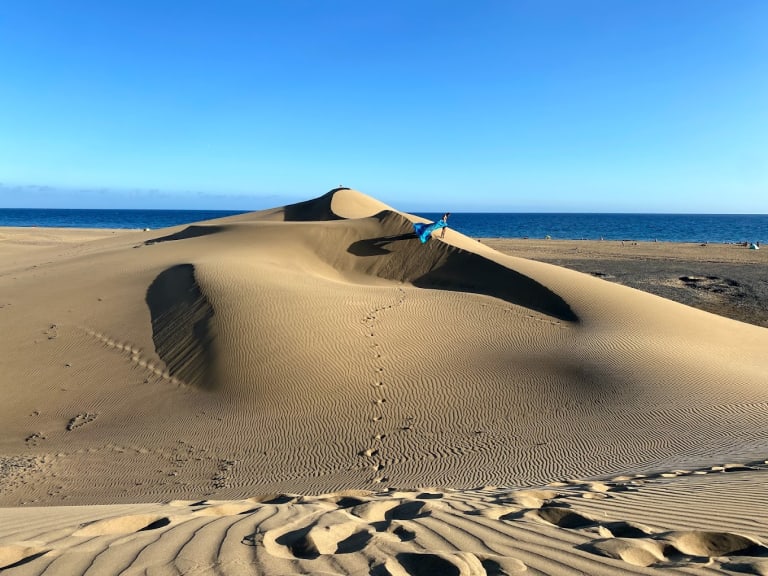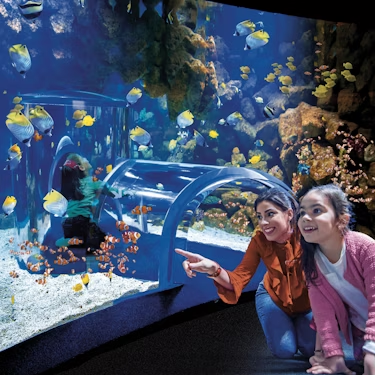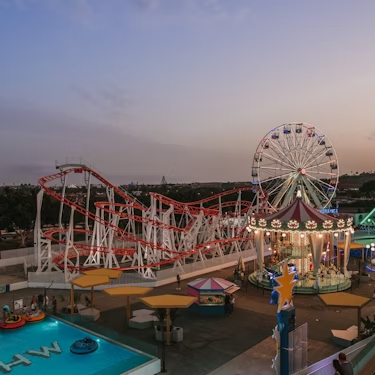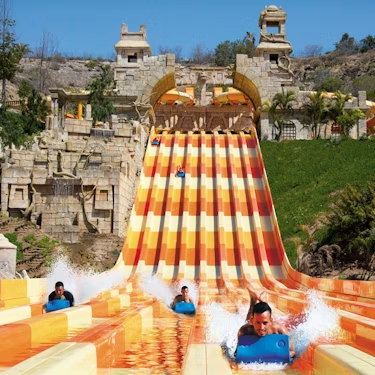More about: Gran Canaria in 7 Days: a guidebook for getting the most out of your visit
If something distinguishes Gran Canaria from other places is that it has attractions for everyone. Deserts, beaches, mountains and seas coexist in one of the most important tourist destinations in Spain and lend themselves to a complete tour. If you are planning a 7-day stay on the island, with the right itinerary you will be able to see the best places.
Among the best things to see and do in Gran Canaria are boat trips, dolphin watching, swimming in the paradisiacal beaches and adventure excursions.
Day 1: Tour of the historic center of Las Palmas de Gran Canaria and visit to the Poema del Mar Aquarium

If you plan to stay during your stay in Las Palmas de Gran Canaria, then the first step will be to visit the main points of the city,
. Thus, you will be able to know the historic center of the capital of the island, the most complete markets and some of the busiest beaches. Also visit the Poema del Mar Aquarium, the largest in the Canary Islands, and enjoy the island's gastronomy.
Take a tour of Vegueta, the old town of Las Palmas
The old town of Las Palmas is characterized by its colonial landscapes, its museums and cobblestone streets that refer to the years of the founding of the city, in the late fifteenth century.
In Vegueta you will be able to visit the Casa de Colón, the Plaza de Santa Ana, the Parque de San Telmo and the Cathedral, the main sites of the old city of Gran Canaria.
The winding narrow streets of the old town are built high up, so I recommend that when you walk around the neighborhood you wear comfortable shoes and bring water to hydrate yourself, especially in summer, as the weather can be very hot. The best time to walk around the neighborhood is during the morning.
If you want to go shopping, you can also do it in the historic district, as you will find a lot of stores in the main street of Triana.
For a lunch stop you can visit the Vegueta Market, which is not that big but has a great variety of stalls to eat.
Tour the Castillo de la Luz
The Castillo de la Luz, now a haven for contemporary art, is one of the most important monuments of Gran Canaria, not only because it houses the historical heritage of the island, but also because during the years of the Viceroyalties of America it marked a forced passage for the fleet of ships returning to Spain, fulfilling a vital defensive work against the siege of pirates.
In the visits to the Castillo de la Luz you can see its drawbridge, the two circular towers, the control booth and the cistern of the inner courtyard. As a curiosity, it is worth mentioning that although it is now surrounded by land, during its construction more than 6 centuries ago it was located on a reef outside the island.
You can get to the Castillo de la Luz from the Vegueta Market by car taking the GC-1 route, by bus line 12 to the Juan Rejón stop or on the hop on-hop off tourist buses of Gran Canaria. The entrance to the Castle has a general admission of 4 euros.
Visit the Poema del Mar Aquarium
A few streets away from the Castillo de la Luz is the Poema del Mar Aquarium, which is the largest in the Canary Islands and also a reserve of the island's natural fauna.
Divided into three thematic exhibits, Jungle, Reef-Beach and Deep Ocean, this aquarium features sharks, dolphins, rays, octopus and crabs, as well as schools of fish and crocodiles.
The aquarium is a perfect alternative in Las Palmas to the best dolphin watching excursions, which usually start in Puerto de Mogán or Playa de Puerto Rico.
The Poema del Mar Aquarium is open daily from 9.30 am to 5 pm and general admission costs approximately 25 euros for adults and 18 euros for children under 11 years old.
The full tour of the aquarium, including the interactive experiences, will take you approximately 3 hours. To close the day with a Canarian experience you can dine at the Mercado del Puerto.
Day 2: Tour of Playa de las Canteras and Playa del Confital and visit to Roque Nublo Natural Monument

A tour of Las Palmas de Gran Canaria will not be complete until you visit the main beaches of the island and that is where the itinerary of the second day begins.
In the afternoon, after lunch, the tour will continue with a half-day excursion to some of the highest points of the island and the Roque Nublo Natural Monument.
Visit Las Canteras Beach and Confital Beach
Located in the west bay of Las Palmas, Playa de las Canteras and Playa del Confital are two of the main beaches of the island's capital. The Confital, located in the Peninsula de la Isleta, stands out for being a naturist beach, inclusive and with ramps for the disabled.
The Confital Beach is a wild beach, so the best time to enjoy it is during the early hours of the morning. When the surfers start arriving, the ideal time to go to Playa de las Canteras, which is 10 blocks away and can be reached by bus line 21.
Playa de las Canteras is the most famous beach in the city and possibly the whole island. It will amaze you with its extension and with the options of diving tours. Among the services offered are a large number of restaurants, so it is the ideal place to have lunch before continuing with the excursions of the second day.
Take a guided excursion to the Roque Nublo Natural Monument
The interior of the island is home to some of the best natural attractions in Spain and you can discover them on some of the best tours in Gran Canaria.
On these excursions you can visit the villages of Teror and San Mateo and take in panoramic views from the volcanic mountain peaks before reaching Roque Nublo.
The National Monument of Roque Nublo is located in the geographical center of Gran Canaria and is one of the symbols of the island, because it has a height of 80 meters in stone of volcanic origin and is more than 1800 meters above sea level. This makes it the third highest point, behind Morro de la Agujereada and Pico de las Nieves.
From Roque Nublo you can access one of the cleanest open views of the island and if you plan to visit Gran Canaria in Decemberor January you can also see the sunset.
Day 3: Visit the Dunes and the Maspalomas Lighthouse and take a dolphin watching excursion

On the third day the itinerary will include a visit to the south of the island to see the unique dunes of Maspalomas, which have a direct correlation with the landscape of the Sahara desert, and the Maspalomas Lighthouse, one of the oldest in Gran Canaria.
During the afternoon, I suggest an excursion with whale and dolphin watching from the beach of Puerto Rico.
Visit the Maspalomas Dunes
Is it possible to visit the Sahara in Gran Canaria? It seems so, at least from the dunes of Maspalomas, because they offer a unique landscape that has similarities with the desert, they even share climate and some of the migratory birds that also inhabit the African continent.
The dunes of Maspalomas can be reached by car from Las Palmas de Gran Canaria by the GC-1 route in a journey of about forty minutes or by bus combining lines L1 and 1 to the station Avenida de Bonn.
The best time to visit the dunes is during the morning, since during the afternoon the heat increases, especially in summer.
The entrance to the Natural Park is free and once inside, with extra cost, you can take a camel ride through the dunes of Maspalomas or a guided tour that will take you through the best landscapes of the site where you can take the best pictures of what is known as the great desert of the Canary Islands.
Visit the Maspalomas Lighthouse and take a bath in Playa del Inglés.
Once you finish the morning tour through the dunes of Maspalomas you can have lunch in some of the coastal restaurants of Playa de las Mujeres and then visit the Maspalomas Lighthouse, one of the oldest in the Canary Islands.
The Maspalomas Lighthouse is a symbol of the Canary Islands and also one of the highest points in the south of the island, along with the Mirador de las Dunas, which you can access in the vicinity of the Hotel Riu Palace.
A few blocks from the lighthouse you can visit Playa del Inglés, the most distinctive of the southern beaches and noted for its golden sand and calm, crystal clear waters, as well as for its enormous extension.
Take a dolphin-sighting tour
A dolphin watching tour is one of the best activities you can do in Gran Canaria. From Playa del Inglés you can reach the beach of Puerto Rico by car on the GC-1 road in about 20 minutes and there hire an excursion to discover the cetaceans of the Canary Islands.
On these afternoon excursions, lasting about 3 hours and with starting prices of 41 euros, you can sail on a cruise in open waters looking for dolphins, whales and other cetaceans of the Canary fauna, such as beaked whales and sperm whales.
During the summer or high season months and when weather conditions permit, the dolphin watching excursion cruises usually make some stops for visitors to take a swim.
Some Gran Canaria boat tour services also include an open bar of soft drinks and reduced rates for children.
Day 4: Visit the Caldera de la Bandama, the Pico de las Nieves and relax in the natural pools of Agaete

If up to this point the tour has not seemed adventurous enough for you, get ready, because the fourth day includes a visit to the Pico de las Nieves, the second highest point of the island, a visit to the volcanic caldera of Bandama and a relaxing swim in the pools of Agaete, on the west coast of Gran Canaria.
Visit the Bandama Caldera
The Caldera de la Bandama is an inactive volcanic caldera that has a viewpoint from which it is possible to contemplate the remains of the volcano and also part of the island.
The tour of the Bandama can be done by two trails, one of which will take you to the bottom of the crater, so if you want to opt for this path ideally you should start very early in the morning.
You can reach the Caldera de la Bandama by car from Las Palmas on the GC-802 road, a 20-minute drive, or by bus, combining lines L1 and 311. If you opt for a guided excursion to Bandama, you will understand the volcanic origins of the Canary Islands and its relationship with the African continent.
Reach the summit of Pico de las Nieves
After the Morro de la Agujereada, the Pico de las Nieves, with more than 1900 meters high, is the highest point of Gran Canaria and if you reach the top you will be able to contemplate some of the most spectacular views of the island.
If the weather conditions are right, you can also experience the strange phenomenon whereby the winds push the clouds against the mountains and are accumulated on the cliffs, creating the sensation that the visitor walks on the clouds.
You can get from the Caldera de la Bandama to the Pico de las Nieves by car through the winding GC-15 route in a journey of just over 40 minutes. You can either reach the summit by car or hire a hiking tour with an expert local guide.
Relax in the natural pools of Agaete
If you want to rest your legs after the exhausting tour of the Caldera de la Bandama and Pico de las Nieves, you can visit Las Salinas.
Las Salinas are formed by three pools in the rocks that constitute a refuge from the strong waves and also generate a space of relaxation, from which it is possible to glimpse, on clear days, the Pico del Teide, on the neighboring island of Tenerife.
Las Salinas de Agaete can be reached by car from the Pico de las Nieves along the GC-150 road in just over an hour.
Day 5: Visit Gáldar and the beach of Sardina del Norte

For the fifth day, and after an adventure tour, I propose you to visit Gáldar, the colonial town in the north of Gran Canaria that was the first capital of the island and still maintains an ancient architecture.
Then you will head to Sardina del Norte Beach, a paradise of crystal clear waters flanked by cliffs and seafood restaurants.
Tour Gáldar, the first capital of the island
If you liked the old town of Las Palmas de Gran Canaria, you will also like Gáldar, a town in the north of the island that still maintains its pre-Hispanic architectural heritage and a large number of colonial attractions.
In Gáldar you can visit the parish church of Santiago, the Teatro Consistorial, La Recova Market and the Parque Arqueológico de la Cueva Pintada, one of the largest remains of rock art in the Canary Islands. The Cueva Pintada is one of the most interesting attractions of the island and you can visit it with free admission during the weekends.
You can reach Gáldar from Las Palmas de Gran Canaria by car on the GC-3 route, a journey of just over half an hour, or by public transport combining the buses of lines 1 and 105.
Visit Sardina del Norte Beach
In Gáldar, Playa de Sardina del Norte is a paradise lost in a coastal town that lacks nothing. On the spectacular beaches you can experience scuba diving, rent kayaks, fish, practice water sports and taste the most delicious local food overlooking the sea.
Sardina del Norte is one of the most beautiful beaches of Gran Canaria and stands out for the crystal blue of its calm waters and the cliff walls that flank the beach area. It is an ideal place to have lunch after touring the historic center of the city and to spend the afternoon waiting for the sunset.
You can reach Sardina del Norte Beach by car in just over 10 minutes or hire some of the local private transport services, as there are no regular buses that make this route.
Day 6: Take a full day adventure tour in the north of the island

If you enjoyed Gáldar and the beaches in the north of Gran Canaria and also the adventure tours in the interior of the island, for the sixth day I propose a full day excursion in the ancient forest of Doramas.
Join the excursion The Rainforest Tour, a full day jungle tour
With these excursions with round trip transfer and hotel pick up, you can visit the Barranco de Azuaje, which is the gateway to the ancient forest of Doramas of Gran Canaria. In this natural area you will visit the Laurisilva Forest and take the first walk of the day following the water course.
During the tour you will also visit the Azuaje Viewpoint, one of the most beautiful of the island, and you can take a swim in some of the natural pools of the ravine.
These adventure tours will immerse you in the exotic green trails of northern Gran Canaria, which still preserves some virgin spaces, and you will learn the stories of the local native peoples and pre-Hispanic inhabitants of the Canary Islands.
These tours usually include entrance fees to attractions, tastings, local guide assistance and transfers in the reference price, which has an approximate starting cost of 81 euros per person.
Day 7: Discover the villages of Agüimes and Telde and tour Los Lirios Winery

On the seventh and last day the itinerary includes a tour of two of the most picturesque villages of Gran Canaria and also a tour of Bodega Los Lirios, one of the main wine producers of the island since its foundation.
Visit Telde and Agüimes, two of the most picturesque villages of the island
Telde is the second most populated city of Gran Canaria, but also a beautiful place that preserves some of the architectural jewels of its pre-Hispanic past, such as the Basilica of San Juan Bautista and the Casino.
In Telde you can also visit the Cueva de Cuatro Puertas and the paradisiacal Playa de Tufia.
Telde can be reached by car from Las Palmas by the GC-3 route in just over 10 minutes and by public transport by bus, combining lines 54 and 12. On the outskirts of the town you can also visit its Landscape Corridor, an ideal place for hiking and cycling.
At 20 kilometers from Telde, by the GC-1 route, you can reach Agüimes by car , which being a little smaller, also stands out for its parish, the Plaza del Rosario and the Bahía de Formas, hence they are considered sister towns.
Close your visit to Gran Canaria with a visit to the Bodega Los Lirios
Los Lirios Winery is one of the most traditional wineries in Gran Canaria and also an essential visit for all those who are touring the island.
Located in Los Lirios, very close to the Cuesta de los Alvarados, this winery and vineyard is an ideal option to close the tour of the Canary Islands with a wine and cheese tasting.
You can reach Los Lirios Winery by car from Agüimes on the GC-1 road and make an afternoon excursion of about 3 hours to taste red wine from the vineyard and taste local products, while you wait for the sunset and plan, why not, a second trip around Gran Canaria.
- Day 1
- Historical center of Las Palmas
- Vegueta Market
- Castle of La Luz
- Aquarium Poem of the Sea
- Day 2
- Las Canteras Beach
- Confital Beach
- Roque Nublo Monument
- Teror and San Mateo
- Day 3
- Dunes of Maspalomas
- Maspalomas Lighthouse
- Puerto Rico beach
- Dolphin watching
- Day 4
- Bandama Caldera
- Pico de las Nieves
- Las Salinas
- Agaete
- Day 5
- Gáldar
- Painted Cave
- Sardina del Norte Beach
- Market of La Recova
- Day 6
- Jungle of the Doramas
- Azuaje Ravine
- Azuaje viewpoint
- Laurisilva Forest
- Day 7
- Telde
- Aguimes
- Cave of Cuatro Puertas
- Los Lirios Winery




